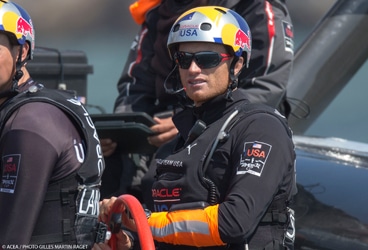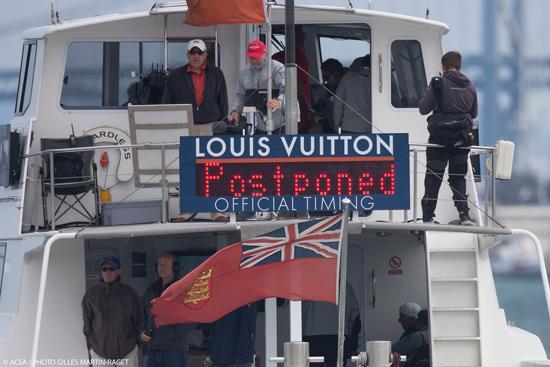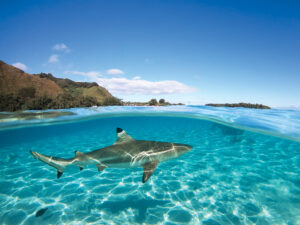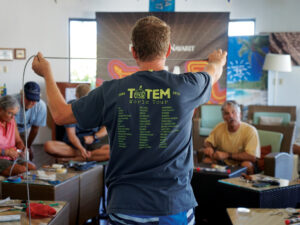
After three days of racing at the 34th Defense of the America’s Cup, the challenger, Emirates Team New Zealand, needs to win five of the next 14 races to defeat Larry Ellison’s Oracle Team USA. In contrast, OTUSA must win ten of the next 14 races to successfully defend. This is a daunting task for the American team, based on the performance of both boats in the five races that have been sailed so far on San Francisco Bay. The USA elected not to sail the second race on Day Three. Skipper Jimmy Spithill said, “It is time we regroup; we need to make some changes.” There is a scheduled lay day before racing resumes on Thursday. Can Spithill and his team turn adversity into victory? It will not be easy.
First, a review of Race Five. Once again, Spithill won the start. For the first time in the match he took the windward position. At the first mark, OTUSA had a nice lead. The wind direction was more southerly than usual. The boats were able to sail on the port jibe for an extraordinary distance toward the leeward gate. This took away any chance for the Kiwis to pass. Approaching the gate, American tactician John Kostecki called for a foiling tack. Their plan was to turn the mark on the foils and immediately tack and sail for the backside of Alcatraz Island, where there is little effect from the flood current. The boat appeared to stop during the turn. The Kiwis made up four boat lengths in a few seconds, and were now out of phase on the opposite tack. Kostecki made a poor choice. The Kiwis were closing.
Sailing upwind at 25 knots, New Zealand was gaining at an impressive rate. When the USA tacked onto starboard, the Kiwis could not cross and dipped behind. New Zealand was sailing fast; the American boat was not. Less than one mile after the turn, the Kiwis took the lead and sailed away. Spithill, Kostecki and the crew all looked stunned. On Sunday they won a tight thriller. They have led at the second mark in three out of five races. Something is wrong with Oracle Team USA. The boat is slow going to windward, and their tactics have been very inconsistent. So what is going on, and what can be done?
John Kostecki is one of the most successful sailors in the world, with an around the world race victory, an America’s Cup win, and an Olympic medal. He grew up sailing on San Francisco Bay and is very familiar in these waters. Throughout the race, Kostecki constantly grinds one of the winches to power the hydraulics, and helps trim the sails. It is hard, exhausting work. Over on the New Zealand boat, the tactician Ray Davies, does not have grinding duties. He looks around and studies the wind, the current and his boat’s performance vs. the USA. As a former America’s Cup tactician, I like to listen to them and watch their performance. Of course, it is easy for me as a television commentator to critique their moves, but I think the physical work for Kostecki (who is 49) might be hurting his ability to look around. The New Zealand boat is set up so the tactician does not grind a winch.

ETNZ syndicate head, Grant Dalton, (who is 56) sails on his team’s boat. In every sport having a seasoned veteran on the team, and in the locker room, is always a benefit. It makes me wonder if it is time for the Oracle team’s manager, Russell Coutts, to get on the boat? After Race Five, Coutts summoned Spithill to his tender for an in-person meeting. Our television camera’s recorded the scene. We don’t know what was said, but I’ll bet there was a difference of opinion on whether to postpone the second race of the day. When asked after the race, Spithill said they talked about the weather. Later he said they discussed rugby. Let there be no doubt that they talked about their performance, and I’ll bet it was a one-way conversation. Coutts has to be under pressure from Larry Ellison to improve. Losing is not in Ellison’s DNA.
Overnight the design team and shore crew will make some changes to the boat to try to find some upwind speed. I like the fact that OTUSA plans to go sailing during the lay day. The Kiwis will spend their time on maintenance, and reviewing strategy.
Time is running out for the USA. Everyone around the waterfront wonders if we will see a crew change. Coutts is certainly available and so is four-time Olympic Champion Ben Ainslie, who served as the in-house training skipper. I don’t think we will see a major crew change for Day Four. But, if the USA loses two on Thursday, we just might see a different roster.
At the post race press conference, I asked Spithill if there was any chance that they would use their other boat. Their first boat is being prepared for racing. Based on my observations Boat One might be a little faster than Boat Two (the one being raced now) when sailing to windward. This is where New Zealand has a distinct advantage. The trade off is that Boat One is slower downwind and is harder to control. I don’t think a boat change is likely, unless there is some damage. Let’s hope we don’t see a collision between these boats. At 40 knots or more, that horrible thought would be a disaster.
The speeds between the USA and NZL are close enough that either boat can win races as we have seen. Oracle Team USA still has time to get rolling, but they must win the next two races and get some momentum. New Zealand needs to improve on the starting line, and keep the pressure on OTUSA so Sptihill and company keep making increasingly desperate moves. We might see Spithill try to get a boat-on-boat penalty during the pre-start. New Zealand will likely be cautious around the starting line. The Kiwis have the speed and boat handling skills to pass when behind. Five more victories and the America’s Cup will be on its way Down Under for the third time in thirty years. The only thing stopping the cup from leaving the USA is the resolve and clear thinking from Ellison, Coutts, Spithill and the rest of the team. Will they find a way to win? We will know soon.
Gary Jobson, President of the National Sailing Hall of Fame, is posting a series of notes on the America’s Cup, which began with his thoughts during the Louis Vuitton Cup and will continue each race day during the America’s Cup.








